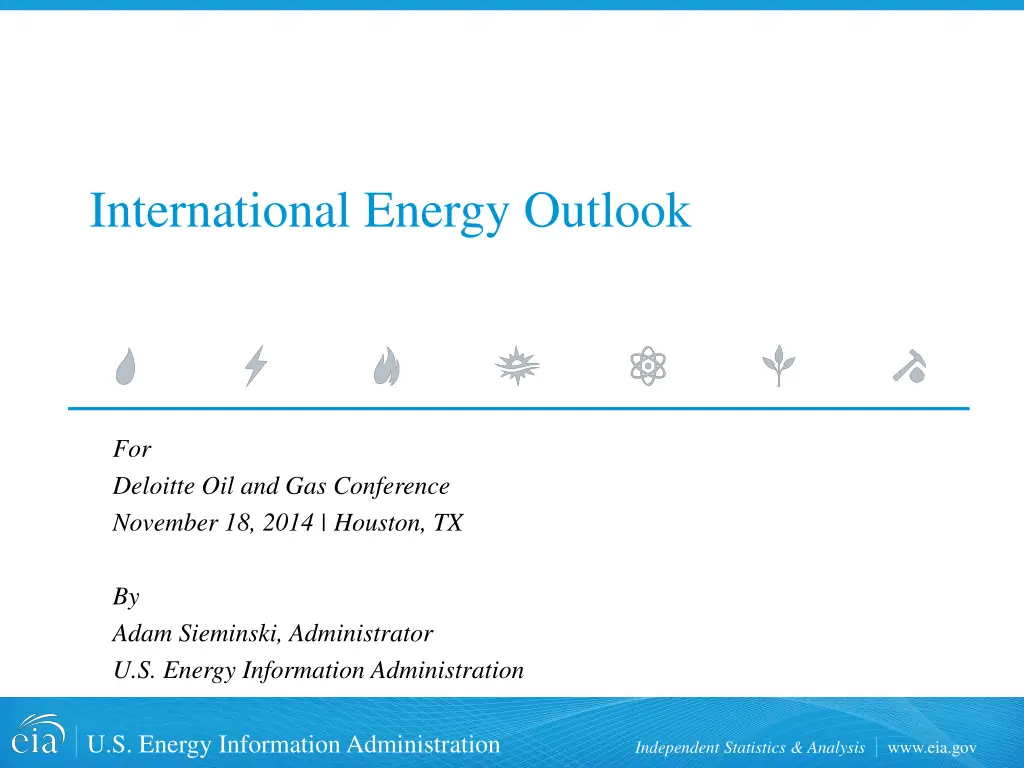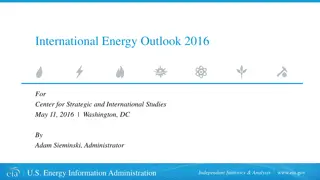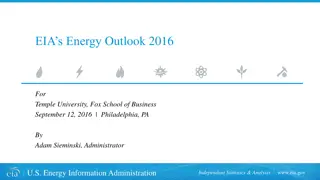
Insights into Global Energy Consumption Trends
Discover key insights from the International Energy Outlook 2014 presented at the Deloitte Oil and Gas Conference. Explore the growth of renewable energy and nuclear power, the dominance of oil in world energy consumption, and the projected increase in liquid fuels demand by 2040. Dive into statistics on world energy consumption, with a focus on non-OECD countries. Uncover details on U.S. oil and natural gas production growth from 2011-2013.
Uploaded on | 2 Views
Download Presentation

Please find below an Image/Link to download the presentation.
The content on the website is provided AS IS for your information and personal use only. It may not be sold, licensed, or shared on other websites without obtaining consent from the author. If you encounter any issues during the download, it is possible that the publisher has removed the file from their server.
You are allowed to download the files provided on this website for personal or commercial use, subject to the condition that they are used lawfully. All files are the property of their respective owners.
The content on the website is provided AS IS for your information and personal use only. It may not be sold, licensed, or shared on other websites without obtaining consent from the author.
E N D
Presentation Transcript
International Energy Outlook For Deloitte Oil and Gas Conference November 18, 2014 | Houston, TX By Adam Sieminski, Administrator U.S. Energy Information Administration U.S. Energy Information Administration www.eia.gov Independent Statistics & Analysis
Renewable energy and nuclear power are the fastest growing sources of energy consumption; oil still dominates world energy consumption by fuel quadrillion Btu History 2010 Projections 250 28% 27% 200 Liquids (including biofuels) 34% Coal 23% Share of world total 150 28% Natural gas 15% 22% 100 Renewables (excluding biofuels) 11% 7% 50 Nuclear 5% 0 1990 1995 2000 2005 2010 2015 2020 2025 2030 2035 2040 Source: EIA, International Energy Outlook 2013 Deloitte Oil and Gas Conference November 18, 2014 2
World energy consumption growth is concentrated in non- OECD countries world energy consumption, 1990-2040 quadrillion Btu History Projections 1,000 800 600 Non-OECD 400 200 OECD 0 1990 2000 2010 2020 2030 2040 Source: EIA, International Energy Outlook 2013 Deloitte Oil and Gas Conference November 18, 2014 3
Results from the IEO2014 Reference case World petroleum and other liquid fuels use increases by 38% between 2010 and 2040, all in the non-OECD Developing Asia (including China and India) and the Middle East account for 85% of the increase Increased demand requires 33 MMbbl/d of additional liquid fuels supplies to reach 119 MMb/d by 2040 OPEC crude and lease condensate increases by 14 MMbbl/d Non-OPEC crude and lease condensate increases by 10 MMbbl/d Other liquid supplies (from NGPL, biofuels, CTL, GTL, and refinery gain) grow in importance, supplying 17% of total liquids production by 2040 Deloitte Oil and Gas Conference November 18, 2014 4
These seven regions accounted for 95% of U.S. oil production growth and all U.S. natural gas production growth from 2011-2013 Source: EIA, Drilling Productivity Report Deloitte Oil and Gas Conference November 18, 2014 5
The U.S. has experienced a rapid increase in natural gas and oil production from shale and other tight resources U.S. tight oil production million barrels of oil per day U.S. dry shale gas production billion cubic feet per day 4.5 40 Eagle Ford (TX) Bakken (MT & ND) Spraberry (TX & NM Permian) Bonespring (TX & NM Permian) Wolfcamp (TX & NM Permian) Delaware (TX & NM Permian) Yeso-Glorieta (TX & NM Permian) Niobrara-Codell (CO, WY) Haynesville Utica (OH, PA & WV) Marcellus Woodford (OK) Granite Wash (OK & TX) Austin Chalk (LA & TX) Monterey (CA) Marcellus (PA & WV) Haynesville (LA & TX) 4.0 35 Eagle Ford (TX) 3.5 30 Fayetteville (AR) 3.0 Barnett (TX) 25 Woodford (OK) 2.5 Bakken (ND) 20 2.0 Antrim (MI, IN, & OH) 15 Utica (OH, PA & WV) 1.5 Rest of US 'shale' 10 1.0 5 0.5 0.0 0 2000 2002 2004 2006 2008 2010 2012 2014 2000 2002 2004 2006 2008 2010 2012 2014 Sources: EIA derived from state administrative data collected by DrillingInfo Inc. Data are through August 2014 and represent EIA s official tight oil & shale gas estimates, but are not survey data. State abbreviations indicate primary state(s). Deloitte Oil and Gas Conference November 18, 2014 6
Resource and technology assumptions have major implications for projected U.S. crude oil production beyond the next few years High Oil and Gas Resource case million barrels per day Reference case million barrels per day 2012 2012 14 14 history projections history projections 12 12 STEO November 2014 U.S. crude oil projection 10 10 tight oil 8 8 tight oil 6 6 other lower 48 states onshore 4 4 other lower 48 states onshore lower 48 states offshore 2 2 lower 48 states offshore Alaska Alaska 0 0 1990 2000 2010 2020 1990 2000 2010 2020 Source: EIA, Annual Energy Outlook 2014; Short Term Energy Outlook, November 2014 Deloitte Oil and Gas Conference November 18, 2014 7
EIA Reference scenario shows world tight oil production increasing to almost 8 million b/d in 2025 tight oil production million barrels per day history projections 2012 10 World (IEO2014 Reference case) 8 6 U.S. (AEO2014 & IEO2014 Reference case) 4 2 0 2005 2010 2015 2020 2025 2030 2035 2040 Source: EIA, Annual Energy Outlook 2014 and International Energy Outlook 2014 Deloitte Oil and Gas Conference November 18, 2014 8
Tight oil production will spread to nations outside of the United States and Canada over the projection tight oil production, Reference case million barrels per day 8 AEO2014 High Resource case 7 2010 2025 2040 6 5 5.0 MMbbl/d in 2015 (STEO) 4 3.9 MMbbl/d in 2014 (STEO) 3 2.9 MMbbl/d in 2013 2 1 0 United States Canada Mexico Russia Argentina China Rest of world Source: EIA, International Energy Outlook 2014 Deloitte Oil and Gas Conference November 18, 2014 9
U.S. is the largest producer of petroleum and natural gas in the world estimated U.S., Russia, and Saudi Arabia petroleum and natural gas production quadrillion Btu million barrels per day of oil equivalent 60.0 30 United States Russia 50.0 25 Saudi Arabia 40.0 20 30.0 natural gas 15 20.0 10 10.0 petro- leum 5 0.0 0 2010 2011 2013 2009 2012 2008 2014e Source: U.S. Energy Information Administration Note: Petroleum production includes crude oil, natural gas liquids, condensates, refinery processing gain, and other liquids, including biofuels; barrels per day oil equivalent were calculated using a conversion factor of 1 barrel oil equivalent=5.55 million British thermal units (Btu) Deloitte Oil and Gas Conference November 18, 2014 10
U.S. oil production growth helping to offset unplanned outages estimated unplanned crude oil production outages million barrels per day 4.0 U.S. Production growth* 3.5 Other Non-OPEC Non- OPEC 3.0 Syria 2.5 Sudan / S. Sudan 2.0 Iraq 1.5 Nigeria OPEC 1.0 Libya 0.5 Iran 0.0 Jan-2012 Source: EIA, Short-Term Energy Outlook, November 2014 *monthly production delta versus Jan. 2011 production level Jul-2012 Jan-2013 Jul-2013 Jan-2014 Jul-2014 Deloitte Oil and Gas Conference November 18, 2014 11
Effect of low oil prices on U.S. shale oil production US+CA, oil+NGLs from tight plays (kbbld) Brent-indexed breakeven prices: Source: Rystad Energy North America Quarterly Shale Report Deloitte Oil and Gas Conference November 18, 2014 12
U.S. shale gas leads growth in total gas production through 2040, when production exceeds 100 billion cubic feet per day U.S. dry natural gas production trillion cubic feet 40 billion cubic feet per day 2012 projections history 100 35 90 30 80 70 25 60 20 Shale gas 50 15 40 Tight gas 30 Non-associated onshore 10 20 Non-associated offshore 5 Alaska 10 Associated with oil Coalbed methane 0 0 1990 1995 2000 2005 2010 2015 2020 2025 2030 2035 2040 Source: EIA, Annual Energy Outlook 2014, Reference case Deloitte Oil and Gas Conference November 18, 2014 13
Natural gas consumption growth is driven by electric power, industrial, and transportation use U.S. dry gas consumption trillion cubic feet 35.0 history projections 30.0 electric power 11.0 25.0 8.5 20.0 industrial* 15.0 11.2 9.1 10.0 transportation** 1.7 3.6 0.7 2.9 commercial 5.0 residential 4.1 4.2 0.0 2005 2012 2020 2025 2030 2035 2040 *Includes combined heat-and-power and lease and plant fuel **Includes pipeline fuel Source: EIA, Annual Energy Outlook 2014, Reference case Deloitte Oil and Gas Conference November 18, 2014 14
U.S. becomes a net exporter of natural gas in the near future U.S. dry natural gas trillion cubic feet per year billion cubic feet per day history projections 2012 40 100 30 75 Consumption 20 50 Domestic supply 10 25 Net exports 0 0 -25 -10 1990 1995 2000 2005 2010 2015 2020 2025 2030 2035 2040 Source: EIA, Annual Energy Outlook 2014 Reference case Deloitte Oil and Gas Conference November 18, 2014 15
Projected U.S. natural gas trade depends on assumptions regarding resources and future technology advances Reference case trillion cubic feet per year High Oil and Gas Resource case trillion cubic feet per year billion cubic feet per day 8 8 20 6 6 15 exports to Mexico exports to Canada 4 4 10 2 2 5 lower 48 LNG exports 0 0 0 imports from Canada -5 -2 -2 LNG imports -10 -4 -4 2010 2015 2020 2025 2010 2015 2020 2025 Source: EIA, Annual Energy Outlook 2014, Reference case and High Oil and Gas Resource case Deloitte Oil and Gas Conference November 18, 2014 16
Most of the growth in production between 2011 and 2015 consists of sweet grades with API gravity of 40 or above U.S. crude oil production by type million barrels of oil per day forecast history 10 9 8 7 6 API 50+ API 40-50 API 35-40 API 27-35 API below 27 5 4 3 2 1 0 2011 2012 2013 2014 2015 Source: EIA, DrillingInfo, Colorado DNR, Texas RRC. http://www.eia.gov/analysis/petroleum/crudetypes/ Deloitte Oil and Gas Conference November 18, 2014 17
Crude oil and associated liquids contain a wide variety of hydrocarbons Source: EIA via Harvey Crude Assay Management System Deloitte Oil and Gas Conference November 18, 2014 18
EIA projects declines in carbon dioxide emissions for all sectors except industrial relative to 2005 Source: EIA Annual Energy Outlook 2014 Deloitte Oil and Gas Conference November 18, 2014 19
Coal continues to account for the largest share of global energy- related carbon dioxide emissions throughout the projection world energy-related carbon dioxide emissions by fuel billion metric tons History 2010 Projections 50.0 40.0 30.0 Coal 20.0 Natural gas 10.0 Liquid fuels 0.0 1990 1995 2000 2005 2010 2015 2020 2025 2030 2035 2040 Source: EIA, International Energy Outlook 2013 Deloitte Oil and Gas Conference November 18, 2014 20
Areas of uncertainty in the outlook Oil prices China s energy demand growth; particularly in transportation Increasing global trade of natural gas and hydrocarbon gas liquids in addition to oil Global development of tight oil and shale gas resources Policy decisions on crude oil exports Impact of geopolitical tensions on energy supply Constraints on CO2 Deloitte Oil and Gas Conference November 18, 2014 21
EIA natural gas production forecasts were revised up significantly between 2013 and 2014 forecasted dry natural gas production billion cubic feet per day 120 100 AEO 2014 80 AEO 2013 60 AEO 2004 actual production history 40 20 0 2000 2005 2010 2015 2020 2025 2030 2035 2040 Source: EIA Annual Energy Outlook; EIA Monthly Natural Gas Production Report Deloitte Oil and Gas Conference November 18, 2014 22
EIA crude oil production forecasts were also revised up substantially between 2013 and 2014 forecasted crude oil production million barrels per day 12 10 AEO 2014 8 AEO 2013 6 AEO 2004 actual production history 4 2 0 2000 2005 2010 2015 2020 2025 2030 2035 2040 Source: EIA Annual Energy Outlook; EIA via state agencies Deloitte Oil and Gas Conference November 18, 2014 23
For more information U.S. Energy Information Administration home page | www.eia.gov Annual Energy Outlook | www.eia.gov/aeo Short-Term Energy Outlook | www.eia.gov/steo International Energy Outlook | www.eia.gov/ieo Monthly Energy Review | www.eia.gov/mer Today in Energy | www.eia.gov/todayinenergy State Energy Portal | www.eia.gov/state Drilling Productivity Report | www.eia.gov/petroleum/drilling/ Deloitte Oil and Gas Conference November 18, 2014 24



